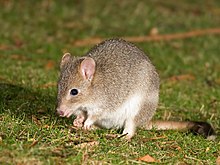| Eastern bettong[1] | |
|---|---|

| |
| Scientific classification | |
| Domain: | Eukaryota |
| Kingdom: | Animalia |
| Phylum: | Chordata |
| Class: | Mammalia |
| Infraclass: | Marsupialia |
| Order: | Diprotodontia |
| Family: | Potoroidae |
| Genus: | Bettongia |
| Species: | B. gaimardi
|
| Binomial name | |
| Bettongia gaimardi (Desmarest, 1822)
| |
| Subspecies | |
|
Bettongia gaimardi cuniculus | |

| |
| Present distribution of Bettongia gaimardi | |
The eastern bettong (Bettongia gaimardi), also known as the southern or Tasmanian bettong, is a small, hopping, rat-like mammal native to grassy forests of southeastern Australia and Tasmania. A member of the rat-kangaroo family (Potoroidae), it is active at night and feeds on fungi and plant roots. Like most marsupials, it carries its young in a pouch. The eastern bettong is under pressure by introduced predators and habitat loss. The subspecies on mainland Australia (B. g. gaimardi) is extinct, but populations of the Tasmanian subspecies (B. g. cuniculus) have been reintroduced there.[1][4]
The animal is called balbo by the Ngunnawal, an Aboriginal people who used to keep them as pets.[dubious – discuss]
- ^ a b Groves, C. P. (2005). Wilson, D. E.; Reeder, D. M. (eds.). Mammal Species of the World: A Taxonomic and Geographic Reference (3rd ed.). Baltimore: Johns Hopkins University Press. p. 57. ISBN 0-801-88221-4. OCLC 62265494.
- ^ Burbidge, A.A.; Woinarski, J.; Johnson, C.N. (2016). "Bettongia gaimardi". IUCN Red List of Threatened Species. 2016: e.T2783A21960911. doi:10.2305/IUCN.UK.2016-1.RLTS.T2783A21960911.en. Retrieved 12 November 2021.
- ^ "Appendices | CITES". cites.org. Retrieved 2022-01-14.
- ^ Rose, R. (1997). Metabolic rate and thermal conductance in a mycophagous marsupial, Bettongia gaimardi. Archived 2008-07-23 at the Wayback Machine The World Wide Web Journal of Biology 2: 2–7.
